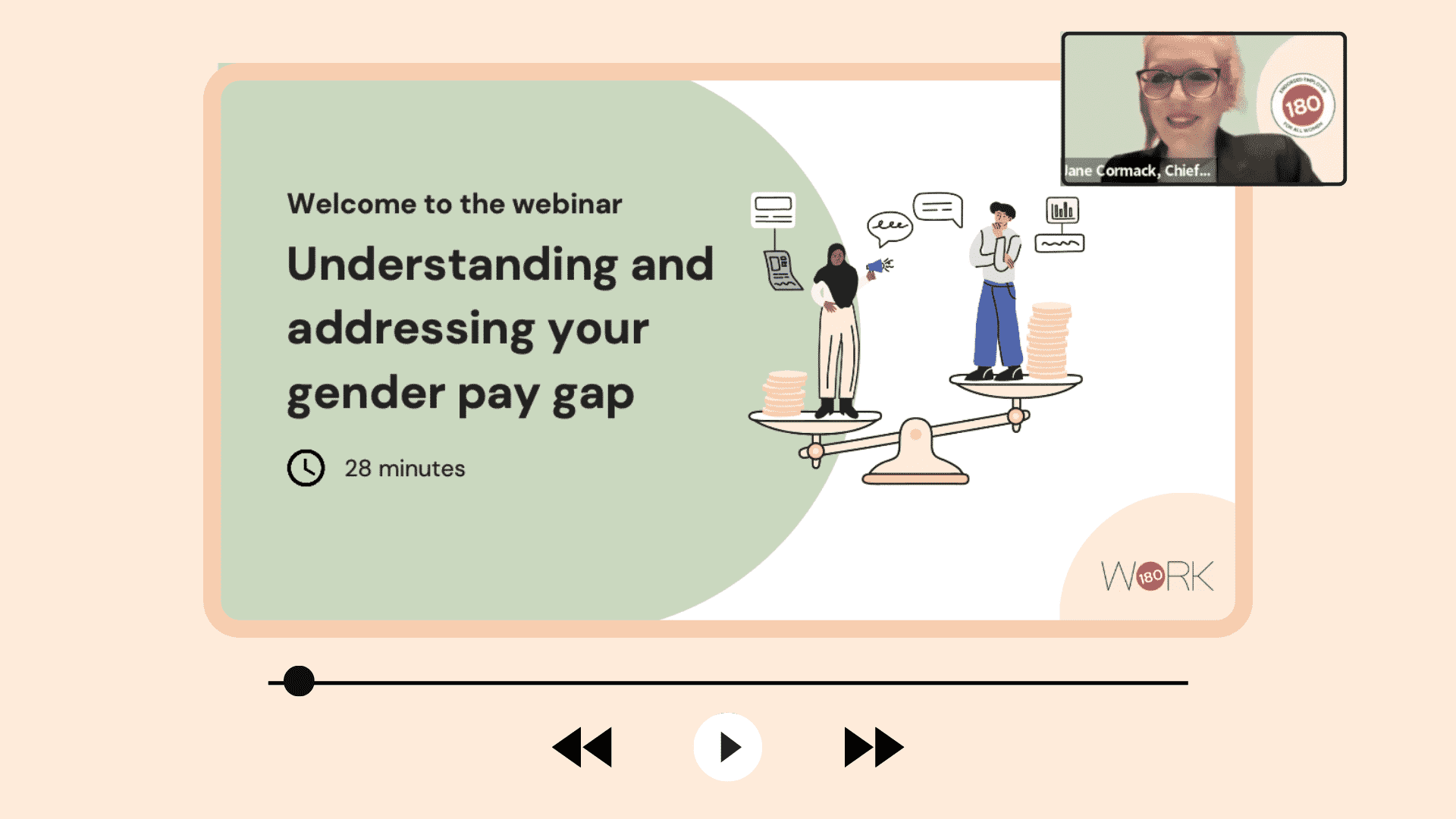To help even more organizations build and benefit from a diverse, equitable, and inclusive workplace, this article details some of the key learnings from our recent EDGE (Employers Driving Gender Equity) think tank: Closing the gender pay gap.
Part of ‘The Game Changing Series’, this exciting knowledge-sharing session brought together team members from a range of organizations in traditionally male-dominated industries, including some of our Endorsed Employers. Each representative generously opened up and shared the challenges and opportunities they’ve found while trying to close their company’s gender pay gap.
Please note: To ensure participants of our WORK180 EDGE events feel fully supported and able to engage in an open, constructive conversation, all key takeaways are anonymized.
The Game Changing Series:
Closing the Gender Pay Gap
Thursday, 14 July 2022 | Online via Zoom

Short on time? Here are the key takeaways
- The upward mobility of women into senior and/or higher paying positions poses one of the greatest opportunities for teams to reduce the gender pay gap in male-dominated industries.
- A few common steps employers are taking to achieve this:
- Actively removing gendered perceptions around impacted roles
- Creating benefits and policies that actively encourage success for women in these roles
- Working to gain greater levels of leadership buy-in and support, which are essential when seeking the resources and focus required to have a real impact
Want to know more and get inspired? Read the full summary notes
Before the conversation began, WORK180’s Jane Cormack covered the key facts and figures around this issue as well as 10 key initiatives to close the gap. This portion of the event was recorded, and is now available to download as an on-demand webinar.

First up, we discussed ‘Why the gap?’
All attendees were from sectors in which women still remain largely underrepresented, despite their roles being gender-neutral across the board. As is so often the case, attendees reported that this underrepresentation is greatest when it comes to positions that are generally higher paid, such as frontline workers in the transport industry or commission-based tech sales team positions.
In a room full of passionate changemakers, all were aware of the opportunity this poses for their company: Getting women into these higher paid positions could help increase average pay for women in their organization and help close their gender pay gap significantly. But they all shared three common challenges that they’re working hard to overcome.
1. Changing perceptions isn’t easy
The cause of women’s underrepresentation in certain roles and sectors is caused by a combination of complex and intersecting factors. One of the many factors that the group honed in on was the prevailing stereotypes and stigmas often attached to these positions. More specifically, it was observed that this seems to have a negative impact on the volume of applications from women candidates.
Attendees in HR and recruitment positions, in particular, discussed their role and responsibility in both raising awareness and changing perceptions of these roles.
Agreed actions:
- Actively market and promote these roles as gender-neutral, internally and externally.
- Provide career development opportunities. For example, one participant from the gaming industry has introduced free coding programs for women within their organization who may be interested in a career change.
- Ensure representation across all recruitment touch points. Specific examples discussed included ensuring diversity in the talent acquisition team itself, and being mindful of representation when attending career fairs.
2. Benefits and policies could make or break efforts
Of course, letting women know that the roles will work for them isn’t enough. There is still work to be done to ensure that the benefits and policies are actively supporting women to thrive in these positions.
A specific example discussed was poor parental leave policies, which have the power to push many women out of the workforce. But, when intentionally improved, it’s clear that these policies have the power to attract and retain women too (as explored in the report Six pressing reasons to improve your parental leave policy).
Here are some specific examples shared by attendees:
- Commission based sales roles offer great earning potential, especially in the tech sector. However, as a Head of Recruitment for a tech organization pointed out, these roles rely on the creation of relationships and networks. Of course, these can be difficult to maintain when taking a time off or working part time. These are two factors that greatly impact those taking parental leave, a demographic that (due to both biological and social factors) remains predominantly women.
The solution: The attendee from this specific organization is working to address this issue by reviewing and improving the structure and support they offer returners during this time.
- Biased hiring and promotion processes is an issue one attendee was paticultlay passionate about eradicating in their global organization. They candidly shared their belief that, if honest, no hiring manager makes decisions free from the fear that women will leave due to parental leave. This is a belief supported by studies, such as that by Slater & Godon which surveyed 500 hiring managers and found that 40% said they’re wary of hiring a woman of childbearing age. A similar number of the participants admitted to also being wary of hiring a woman who has already had a child or hiring a mother for a senior role. This is despite clear laws against such discrimination.
The solution: In an equally candid manner, the passionate changemaker said this issue will only be achieved when hiring managers are just as “scared” of men leaving for parental leave as they are women. To achieve this, many of the attendees have already implemented (or are implementing) policy changes such gender neutral wording and increasing secondary carer’s leave.
Did you know?
Increased leave for secondary carers can help. A Swedish study found that women are more likely to remain in full-time employment, experience a smaller wage gap, and occupy leadership and board positions. The study also found that for every month a new father takes off, the mother’s income rises 6.7% when measured four years later.
Find out more facts, figures, and data-driven guidance in our report: Six pressing reasons to improve your parental leave policy.
Other benefits and policies discussed…
The changemakers in attendance shared a wide-range of improvements to policies that are having incremental changes to their gender pay gap. The two most popular policies discussed during the one-hour conversation were flexible working and pay transparency.
Flexible working:
While the attendees discussed the growing trend for competing employers to miss-sell their hybrid models as flexible working, they agreed that when done well;
- flexible working policies can attract and retain women into underrepresented industries;
- do not have a negative impact on productivity (with one attendee sharing that productivity and share price have in fact increased since implementing greater flexibility);
- require the policy makers to ensure that it’s implemented in a way that works for employees/must not be tokenistic.
Pay transparency:
Attendees shared anecdotal evidence of the continued ‘ask gap’ between genders, which is the term used to describe the reported tendency of men to ask for more money in comparison to women. Here are a few ways attendees are playing their part in addressing this issue:
- Adding salary ranges to job advertisements
- Reviewing and updating pay grades of current roles in order to address current discrepancies, which allows them to then add pay ranges on advertisements for new roles
- Removing questions around previous salary in interviews, or replacing them with questions around salary expectation
3. Progress is being made, but it’s too slow
As we neared the end of our time together, the attendees were sure to inspire each other with success stories. This included the news from one attendee that their level of women in leadership was now at 35%. This is fantastic progress when considering that according to WISE1, just 23% of the UK working in STEMM (Science, Technology, Engineering, Mathematics, and Medicine) are women. What’s more, only 5% of leadership positions in the technology industry are held by women.
However, progress remains slow. And when asked why they think this is, the majority of attendees identified leadership support and buy-in as their biggest barrier to progress. They also agreed that to achieve this, the majority of leadership teams need a clear, data-driven business case that can prove the positive financial impact.
Get the numbers you need to have a real impact
Our Equity Audit offers a holistic view of your organizational commitment to equity, adopting an intersectional lens to highlight your gaps and strengths.
This is supported by an action plan and unique benchmarking data for assessing your employer value proposition.
How did we conclude the conversation?
It’s not over yet! While we left with plenty more to discuss, each of the participants will be invited to attend our next session. If you’re an Endorsed Employer and would like to attend one of our upcoming sessions, be sure to reach out to your DEI Account Manager.
For those yet to be endorsed by WORK180 and interested in getting involved in the conversation, talk to our team today.
Finally, we’d like to thank all the employers who attended for such an open and honest discussion. Together, we can help create a working world where all women can thrive.



